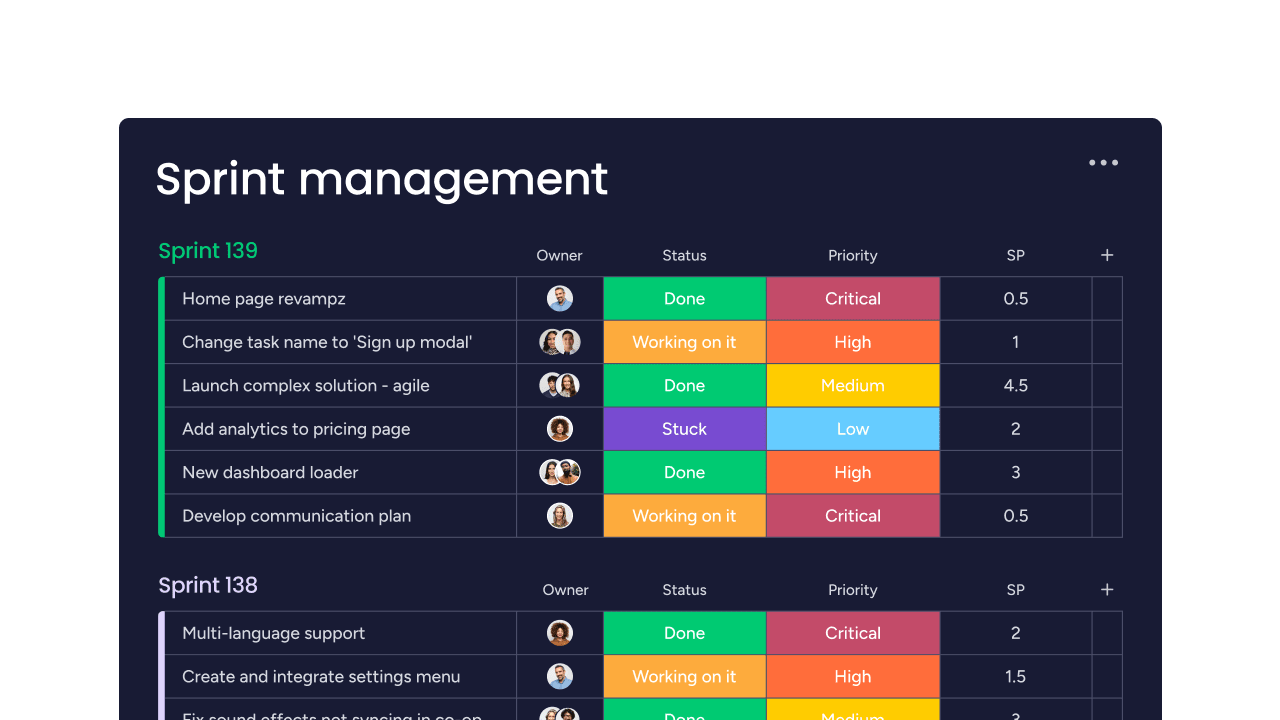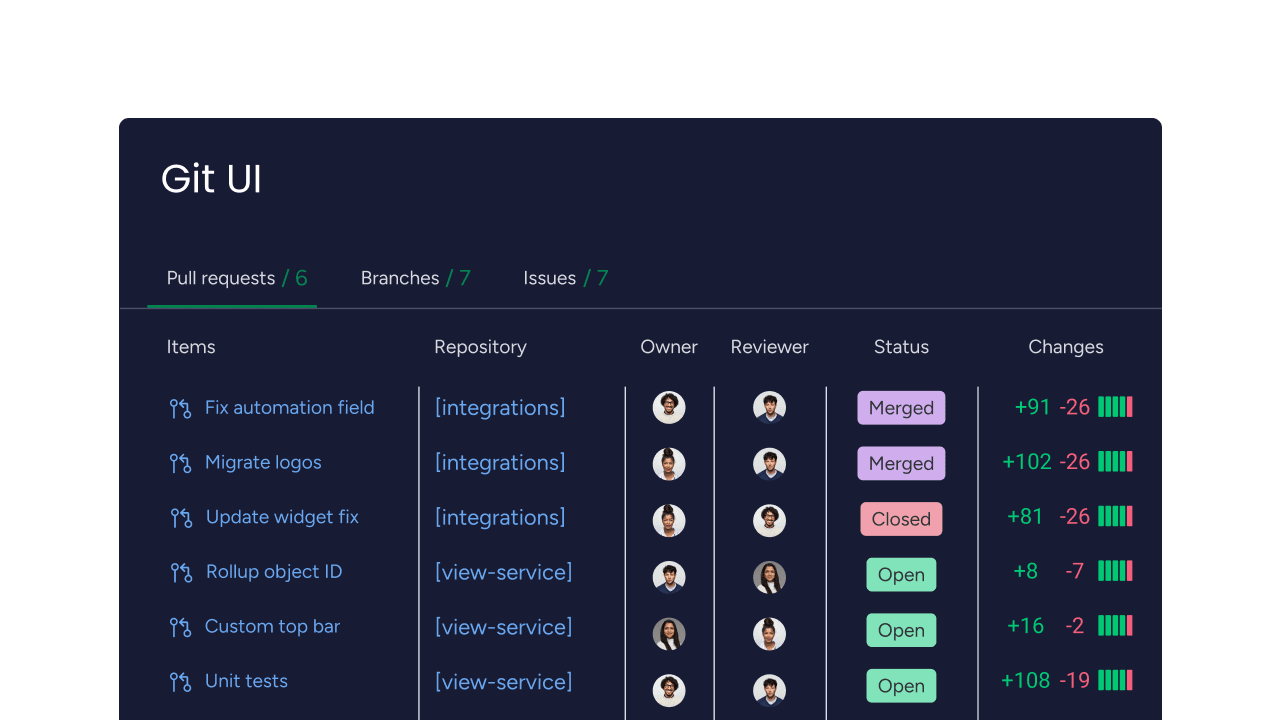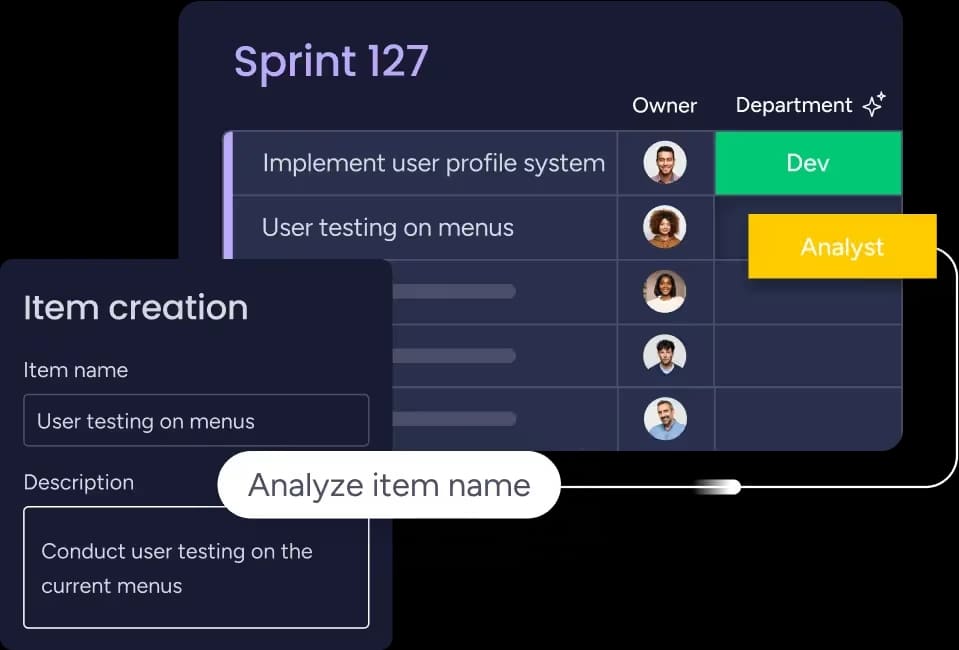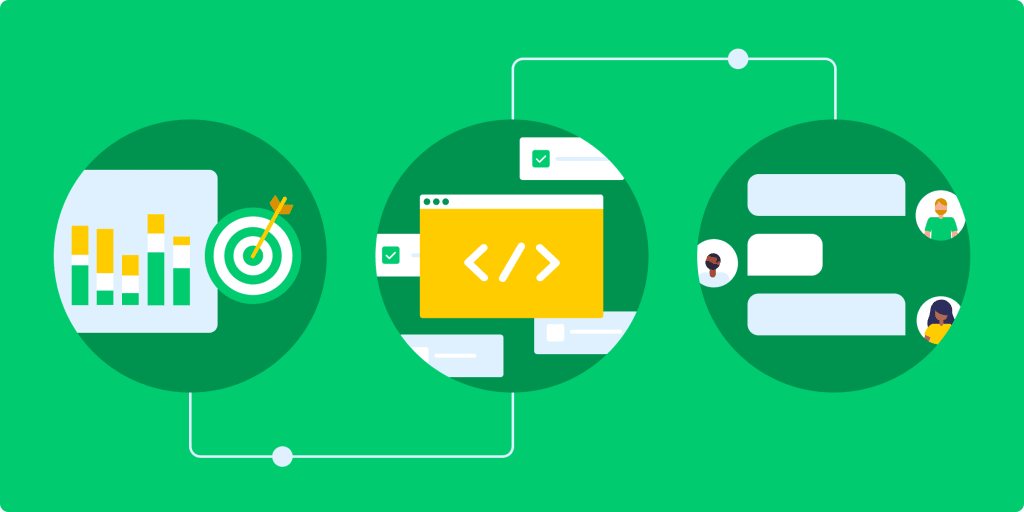Managing software projects has never been more complex or more critical to business success. Whether building innovative products from scratch, rolling out new features, or integrating essential tools, today’s software teams must navigate shifting requirements, tight timelines, and ever-higher user expectations.
But without the right approach and purpose-built tools, even the most talented teams risk delays, miscommunication, and missed opportunities.
In this guide, you’ll discover what sets modern software development project management apart, how leading teams align strategy with execution, and where AI-powered tools fit in. We’ll share best practices for project managers and show how platforms like monday dev transform common challenges into competitive advantages.
Try monday devKey takeaways
- Software development project management (SDPM) ensures structured planning, execution, and delivery of quality software.
- Software project management (SPM) aligns teams, optimizes resources, mitigates risks, and drives business outcomes.
- Agile, Scrum, Kanban, and Waterfall can be tailored to both development projects and broader initiatives.
- AI features like risk analysis, sprint summaries, and forecasting are now central to SDPM.
- The right tools and practices ensure timely releases and continuous improvement.
- Manage software projects easily with monday dev’s flexible workflows, real-time visibility, automation, and collaboration.
What is software project management?
Software project management (SPM) is the discipline of overseeing any project where software is at the center, whether or not it involves active coding. This includes initiatives like system implementations, migrations, integrations, upgrades, and vendor-led rollouts — as well as full-scale development.
Some real-world examples include:
- A startup preparing for the launch of its first SaaS platform
- An enterprise migrating decades of legacy data to a secure cloud environment
- A healthcare provider integrating patient records with an external API for telemedicine
- A global company rolling out new features across distributed teams and regions
- A retailer collaborating with software vendors to deliver a unified e-commerce solution
Managing these types projects requires a structured approach to timelines, budget, risk, stakeholder expectations, and quality control across the entire project lifecycle.
Why is software project management important?
Effective software project management is crucial for consistently delivering high-quality results, controlling costs, and minimizing risk. Without structured management, projects often face missed deadlines, budget overruns, and outputs that fail to meet stakeholder needs or compliance requirements.
- Ensures clarity and alignment: Keeps objectives, deliverables, and deadlines clear for all participants throughout the project lifecycle.
- Optimizes resource usage: Enables teams to allocate time, talent, and budgets efficiently — avoiding burnout and wasted effort.
- Mitigates risks: Identifies and addresses potential blockers, technical challenges, and external dependencies before they escalate.
- Improves communication: Bridges the gap between developers, business stakeholders, and external vendors for smooth collaboration.
- Drives successful delivery: Enhances software quality, user satisfaction, and business value by meeting or exceeding project goals.
What is software development project management?
Software development project management (SDPM) is a subset of SPM focused specifically on the creation and evolution of software itself. This includes building, enhancing, and maintaining products, applications, or platforms through the software development lifecycle (SDLC).
This discipline involves selecting and applying software development methodologies — such as Agile, Scrum, Kanban, or Waterfall — to ensure projects progress smoothly from conception through deployment and maintenance. It also includes setting goals, managing teams, overseeing code quality, tracking progress, and meeting delivery timelines.
Key aspects of SDPM include:
- Aligning requirements and goals with business needs
- Planning, scheduling, and managing resources
- Coordinating cross-functional teams (developers, QA, designers, stakeholders)
- Managing sprints, releases, versioning, and continuous improvement
- Ensuring delivery meets quality standards and user expectations
Why is software development project management important?
Effective project management for software development is critical to delivering reliable, valuable software on time and within scope.
- Reduces risk of delays and rework: Provides structure and accountability across the software development lifecycle (SDLC).
- Ensures stakeholder alignment: Keeps technical and non-technical participants on the same page, bridging business goals and engineering execution.
- Supports adaptability: Helps teams reallocate resources and adjust quickly to shifting scope or priorities.
- Drives continuous improvement: Promotes retrospectives and feedback loops to refine processes and boost future performance.
- Enhances quality and user satisfaction: Enforces rigorous testing, code reviews, and structured releases that meet user expectations.
Software development vs software project management
The table below highlights the main differences and overlaps between software development project management and software project management, so you can decide which approach suits your needs.
| Aspect | Software development project management | Software project management |
|---|---|---|
| Scope | Building, enhancing, and maintaining software | Any project with software at its core—development, implementation, migration, integration, upgrades |
| Primary goals | Deliver new features, releases, code quality | Successful completion of any software-related initiative — may include non-development tasks |
| Typical project types | App/platform development, updates, bug fixes | Deployment, configuration, third-party integrations, migrations, vendor management |
| Methodologies used | SDLC (Waterfall, Agile, Scrum, Kanban) | Project management frameworks (PMI, PRINCE2, Agile for IT) |
| Stakeholders | Product owners, developers, engineers, QA | IT managers, vendors, business leads, cross-functional teams |
| Focus of oversight | Coding, testing, deployment, ongoing releases | Requirements gathering, scheduling, risk management, cross-org coordination |
| Key deliverables | Software builds, versions, release notes | Rollout plans, integrated systems, migration documentation |
How to choose between SPM and SDPM
Many organizations blend both forms of project management, tailoring their approach to specific goals, team skills, and project scope. But as a general rule of thumb:
- If the outcome is a new product, feature set, or technical upgrade: Use software development project management’s SDLC-driven approaches for planning, execution, and delivery.
- If the initiative involves migration, implementation, integration, or vendor management: Use general software project management strategies that combine technical oversight with business and operational considerations.
Choosing the right approach ensures clarity, minimizes risk, and drives better results for every type of software-focused initiative.
Types of software projects
Software projects can be categorized into development-focused projects and broader software initiatives, each with unique management needs and outcomes. Here’s an explanation of each:
Software development projects
- Applications (apps): Building web/mobile apps, desktop software, or SaaS platforms — from initial design to deployment and updates.
- Platforms: Developing scalable frameworks or ecosystems, such as APIs, cloud-based services, or enterprise solutions.
- Embedded systems: Creating software that runs on hardware devices (IoT gadgets, automotive, medical equipment), often requiring specialized skills and rigorous testing.
Broader software projects
- Configuration and deployment: Customizing, setting up, and launching ready-made software within an organization, including user onboarding and policy integration.
- Integrations: Connecting various technologies, apps, or APIs so they work together and share data — crucial for business automation and digital workflows.
- Digital transformations: Large-scale initiatives to modernize legacy systems, move to cloud platforms, or overhaul organizational processes using new technology.
- Migrations: Transferring systems, data, or workflows from old software to new — including upgrades, cloud moves, or vendor switches.
- Vendor implementation: Managing software projects that involve coordination with external partners or suppliers for specialized services or solutions.
Understanding these categories helps teams select the right project management methodologies, tools, and workflows for their specific goals and challenges.
Popular methodologies used in software projects
Teams can choose from different software development methodologies for both development-focused projects and broader software initiatives, adapting each to fit specific goals and team environments.
- Agile: An iterative, flexible approach focusing on continuous delivery and fast feedback, Agile is used for both development (new features, updates) and broader projects (migrations, integrations) where requirements can evolve.
- Scrum: An Agile framework dividing work into sprints (short, time-boxed development cycles) with clear roles (Scrum master, Product owner), Scrum is ideal for teams regularly releasing new features or tackling complex development cycles.
- Kanban: A visual method emphasizing workflow transparency and ongoing prioritization, Kanban is suitable for both bug-fix/maintenance projects and operational improvements, allowing teams to manage work-in-progress and optimize throughput.
- Waterfall: A traditional, sequential approach where each phase (requirements, design, development, testing, deployment) is completed before moving to the next, Waterfall is preferred for well-defined projects with clear deliverables, such as implementations or large-scale migrations.
- Hybrid: A combination of elements from Agile, Waterfall, or other methodologies, hybrid is tailored to meet project needs and applies when some teams require structure but others need flexibility, such as digital transformations or platform upgrades.
Selecting the right methodology helps teams manage complexity, adapt to change, and deliver value efficiently, whether building software from scratch or handling broader technology projects.
Common phases in software development project management
Although there isn’t a universally accepted number of phases for the software development life cycle (SDLC) — some models describe 5 stages, others 6 or 7 — most agree that successful projects pass through these common phases:
- Planning: Define goals, scope, stakeholders, budget, and timelines. This stage may include creating a product roadmap and estimating resources.
- Design: Develop system architecture, user flows, or prototypes to align technical and business expectations.
- Development: Write and review code, configure platforms, and build features based on requirements.
- Testing: Validate functionality, performance, and security through regular testing cycles.
- Deployment: Release software to users — sometimes through soft launches or beta testing before a full rollout.
- Maintenance: Provide ongoing updates, fixes, and enhancements to keep the software secure and relevant.
Some frameworks add a final “Retirement” phase for end-of-life products, while others combine design and planning into a single step.
The takeaway here is that while labels and structures differ, every team follows the same core flow: turning an idea into a build, releasing it, and keeping it running.
Key roles in software projects
A successful software project involves coordinated efforts from multiple roles, each with distinct responsibilities that may vary depending on project type. Matching roles and responsibilities to project type improves communication, accountability, and the likelihood of successful outcomes.
| Role | Responsibilities | Emphasis by project type |
|---|---|---|
| Project manager | Oversees planning, execution, resources, risk management, and stakeholder communication | Equally important in both project types; more coordination with IT and vendors in broader initiatives |
| Product owner | Defines vision and priorities, manages requirements, connects end-users with the dev team | Central in development projects (especially Agile); less involved in broader projects |
| Developers | Write code, implement features, and resolve technical challenges | Core to development projects; support integrations and vendor work in broader projects |
| Quality assurance (QA) | Test applications, validate fixes, and ensure performance, functionality, and security | Focus on new builds in development projects; focus on configuration and integration accuracy in broader projects |
| Stakeholders | Business leaders, end-users, sponsors, compliance officers, external partners | Primarily internal in development projects; broader and cross-functional in larger initiatives |
Best practices for software development project managers
Effective project managers drive successful outcomes by combining strategic oversight, technical awareness, and strong leadership throughout every software development project.
- Set clear goals and requirements: Collaborate with stakeholders and product owners to define objectives, prioritize features, and document user stories early in the project lifecycle.
- Choose the right methodology: Select Agile, Scrum, Kanban, or hybrid approaches based on team skills, project complexity, and stakeholder needs, and remain flexible as requirements evolve.
- Promote transparency and communication: Hold regular stand-ups, sprint planning, and retrospective meetings. Use visual boards and dashboards — like those in monday dev — to keep everyone aligned and informed.
- Leverage integrated tools and automation: Utilize project management platforms for task tracking, sprint planning, and workflow automation, plus integrate GitHub, CI/CD, Slack, and documentation tools for seamless collaboration.
- Monitor risks and adapt: Continuously identify blockers, resource constraints, or scope changes. Use AI-powered solutions to surface potential issues early and adjust plans proactively.
- Encourage continuous improvement: Host retrospectives and feedback sessions to learn from each sprint, boost morale, and refine processes for ongoing performance gains.
- Maintain high-quality standards: Prioritize thorough testing, peer code reviews, and clear documentation at every phase to ensure reliable, secure releases and happy users.
Following these best practices helps software development project managers achieve timely, high-quality results and build a motivated, productive team.
Challenges that impact software project management and how to avoid them
Both software development projects and broader software initiatives face recurring challenges, but modern platforms like monday dev offer smart solutions for overcoming these hurdles.
Typical challenges
- Lack of alignment: Teams may struggle to stay on the same page regarding goals, requirements, and priorities, leading to miscommunication and wasted effort.
- Limited visibility: Tracking project progress, risks, and dependencies can be challenging, especially when managing distributed teams or complex workflows.
- Collaboration silos: Technical and non-technical teams often work in isolation, causing slowdowns and gaps in information sharing.
- Scope creep and shifting requirements: Frequent changes or unclear project objectives can result in missed deadlines, additional costs, and feature bloat.
- Resource bottlenecks: Inefficient allocation and unexpected workload spikes can overwhelm engineers or leave work unfinished.
- Quality risks: Insufficient testing, poor documentation, or a lack of process rigor lead to bugs, security issues, and customer dissatisfaction.
Smart solutions
- Establish shared goals and documentation: Use agreed-upon roadmaps, requirements documents, and regular check-ins to align all stakeholders from the start.
- Implement transparent reporting: Set up dashboards, status updates, and progress charts that are visible to the whole team.
- Encourage cross-functional collaboration: Hold joint planning sessions and retrospectives with all relevant departments to break down silos.
- Prioritize scope management: Use structured backlog management and regular grooming sessions to continuously evaluate, trim, or reprioritize features as requirements evolve.
- Monitor workloads and resources: Track team capacity and reassign work or adjust timelines before bottlenecks appear.
- Invest in robust QA and feedback cycles: Integrate thorough testing, code reviews, and customer/user feedback at every development phase to catch quality issues early and drive continuous improvement.
Things to look for in your software development project management platform
As projects grow in complexity, investing in a project management platform isn’t just a convenience — it’s a strategic necessity. The right solution empowers teams to maintain alignment, respond rapidly to changes, enhance transparency, and ensure consistent, high-quality delivery.
Before selecting a platform, consider whether it will genuinely support your team’s need for centralized coordination, scalable collaboration, process optimization, intelligent insight, and secure, seamless integration with your existing tools. Prioritizing these features ensures your software development team can deliver high-quality results with agility, clarity, and lasting value.
- Workflow flexibility: The platform should support Agile, Scrum, Kanban, hybrid, and custom workflows, allowing teams to switch and tailor processes as projects evolve.
- Ease of use and onboarding: Look for intuitive interfaces, robust onboarding resources, and minimal configuration hurdles to help teams start quickly — especially important for mixed expert groups or fast-growing teams.
- Integrated collaboration tools: Features that enable real-time communication, shared documentation, comments, notifications, and integration with external tools, such as GitHub and Slack, boost transparency and teamwork.
- Robust reporting and analytics: Built-in dashboards, portfolio overviews, sprint burndown charts, and customizable views offer instant insight into progress, bottlenecks, and resource allocation.
- Automation and AI capabilities: Advanced automation and AI features, such as risk detection, task assignment, and sprint planning, save manual work and help foresee potential issues early.
- Security and compliance: Enterprise-grade security, user permissions, data control, and industry compliance should be standard for protecting sensitive code and project data.
- Scalability and support: The platform must scale with team size and complexity, and offer responsive support, helpful knowledge bases, and further integration options for the future.
Improve your software development projects with monday dev
Built on monday.com Work OS, monday dev is a frictionless, AI-powered platform to plan, track, and deliver software projects. It offers built-in flexibility, ease of use, and advanced reporting — no add-ons needed — allowing teams to work in the way that fits them best and empowering them to move faster, iterate quickly, and execute projects with greater efficiency.
Customizable workflows: Tailor templates, boards, and processes with custom columns, statuses, and automations using the intuitive, no-code, drag-and-drop interface — no admin expertise required.

Multiple methodologies: Handle Agile, Waterfall, hybrid, and custom projects side by side with equal ease.
End-to-end visibility: Instantly track insights into project progress, blockers, and completion rates with Agile insights, performance dashboards, and hierarchies out of the box.
Seamless integration: Connect with essential development tools, such as GitHub, CircleCI, and Slack.

Cross-functional collaboration: Eliminate silos by linking boards, docs, comments, and notifications in one shared workspace, supporting cross-functional alignment between engineers, business leads, and external partners.
AI-powered management: Leverage built-in AI actions for risk analysis, sentiment detection, resource assignment, and sprint summaries to surface bottlenecks, forecast velocity, and automate routine work.

By adopting monday dev, software teams can streamline development cycles, break down silos, adapt swiftly to change, and deliver high-quality products with agility and transparency. Try monday dev free for 14 days to see how your next software project could run smarter.
Try monday devFAQs
What are the benefits of software development project management?
Software development project management ensures teams deliver reliable, high-quality software efficiently and on schedule. It improves collaboration, transparency, and accountability while reducing risks and errors. By organizing tasks, tracking progress, and aligning goals, platforms like monday dev also enable faster adaptation to change and better stakeholder satisfaction.
What is the software development lifecycle (SDLC)?
The software development lifecycle (SDLC) is a structured process that guides software creation from initial requirements and design through development, testing, deployment, and ongoing maintenance. It ensures each stage is planned, tracked, and documented, resulting in reliable software delivered efficiently to users.
How does the Agile methodology benefit software projects?
The Agile methodology enables teams to adapt quickly to changing requirements by organizing work into short, iterative cycles called sprints. Agile promotes frequent feedback, collaboration, and continuous improvement, reducing risk and helping deliver valuable features faster and with greater flexibility.
What does a software project manager do?
A software project manager leads all phases of software projects — defining requirements, building schedules, allocating resources, managing risks, facilitating communication, and tracking progress. They ensure teams deliver high-quality software on time and within budget, aligning technical execution with business goals.
What skills does a software project manager need?
A software project manager should have strong leadership, communication, problem-solving, and technical awareness. Key skills include risk management, scheduling, stakeholder engagement, and the ability to motivate teams. Familiarity with project management methodologies and tools is essential for driving successful software deliveries.
Can software project management platforms integrate with version control tools like GitHub?
Yes, many project management platforms, including monday dev, offer seamless integration with version control tools like GitHub. This enables teams to link commits, pull requests, and code updates directly to project tasks, keeping development progress transparent and reducing manual tracking.
Related: Project management industries, Project management for software engineers, Project management for startups, Project management for freelancers, Project management for non-project managers
 Get started
Get started 


